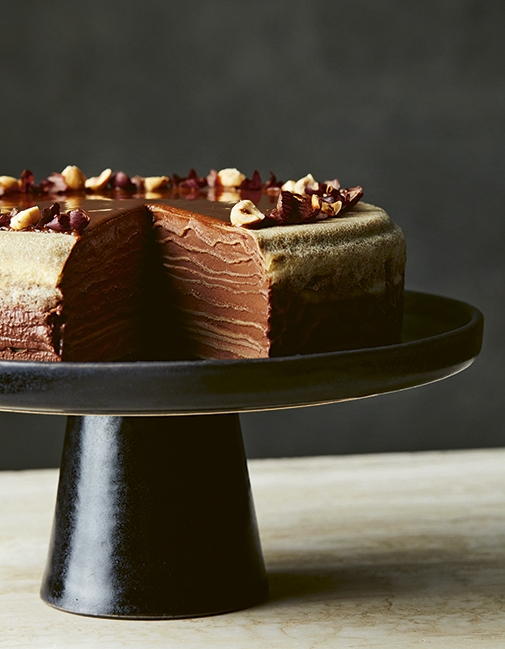Get Premium access to all the latest content online
Subscribe and view full print editions online... Subscribe
Makes Cakes, Bread and Pastries
Preheat the oven to 180C/
160C F/Gas 4. To make the
hazelnut praline, line a large
baking sheet with baking paper.
Spread the hazelnuts out over
another large baking sheet and
roast for 16–20 minutes until
they are golden or, when you carefully take one out and cut
it in half, the centre has a light
golden colour. Leave to cool
slightly, then transfer them to the lined baking sheet.
To make a dry caramel, heat a pan over a medium-high heat and add 1tsp caster sugar. Wait until it melts, then start sprinkling in more sugar slowly while stirring or swirling the pan around. Don’t add too much or you will get big lumps, which take longer to melt – adding the right amount more slowly will melt the sugar so it starts to caramelise. Once it reaches a rich golden colour, add the vanilla pod, then carefully pour the caramel over the hazelnuts and sprinkle with the salt. Leave to cool completely at room temperature.
When cool, break up the
caramel nuts and transfer to a blender or food processor
with the vanilla pod and
pulse to a powder. Scrape the
container, then keep blending.
As the hazelnuts get ground
finer and finer it will warm up– the oils will separate and a
paste will form.
To make the gianduja
Chantilly, heat the unchilled
plant-based milk in a
microwave-safe bowl or jug
in the microwave for 1 minute,
or in a medium pan on the
hob, until it reaches 60C on
a cook’s thermometer.
Meanwhile, add the dark
chocolate, 100g of the hazelnut
praline (reserving the rest),
and the coconut oil to a large
heatproof bowl, then pour in
the warm milk and leave to
stand for 1 minute to melt the
chocolate. Use a hand-held
blender to blend the mixture
together until it is glossy. Add
the chilled plant-based milk
and blend again. Pour it into a shallow container so it is not more than 2cm deep, cover
the surface with cling film and
leave to chill in the fridge for at least 4 hours.
Transfer the set mixture to a large bowl to whisk by hand, or to a stand mixer fitted with a whisk attachment and whisk it on medium speed. The mixture will become quite liquid, so increase the speed to high and continue whisking until it reaches a stable peak. Use immediately.
To make the crêpe batter, blend all the ingredients except the spray oil with a hand-held blender in a large bowl or in a high-powered blender. Alternatively, put the dry ingredients in a large bowl, add half the liquid and mix to a paste with a whisk, then let it down with the remaining milk so you produce a lump-free batter. It will need to be runny and able to coat a pan when you swirl it around.
Heat a flat pan at least 20–22cm in diameter over a medium heat. Spray some oil in it and brush it around the pan.
Use a small ladle to pour some batter into the pan – it shouldn’t be too hot or the batter won’t spread well. You may need to sacrifice the first one or two crêpes to find the right temperature. It’s also useful to do a test one so you know how much batter to use. You want the crêpes to be very thin, so the batter should coat the pan in a thin layer and not overlap on itself too much as you swirl the pan around. Once swirled around, the batter will look set and start to steam. Cook for under 1 minute until the base of the crêpe has picked up some colour. Remove from the pan and repeat until you have used up all the batter. Layer the crêpes with baking paper.
To assemble the gateau, line the base and sides of a 20cm springform tin with baking paper, spraying with a bit of oil to help the paper stick to the sides.
Overlap 3–4 crêpes, then use them to line the tin so they fill the corners and hang over the top edges.
Use a piping bag fitted with a 1cm plain tube, or cut a 1cm hole, to pipe a 4mm layer of the whipped gianduja chantilly. Use a piping bag to pipe a couple of rings of the reserved hazelnut praline or use a spoon to drizzle some praline over the cream.
Gently press a crêpe on to the whipped cream and repeat
with another layer of cream
and praline so you have at least
10–12 layers to fill your tin. Finish
with a crêpe. Reserve some
praline to decorate the cake later.
Tuck the overhanging crêpes inwards over the base, then place a heavy, flat dish on top to weigh the cake down into the tin. Put in the fridge to chill for 4 hours or until set.
When ready to finish, turn
the cake over on to a plate and
release the clasp to remove
the cake. Peel away the paper,
then spread a thin layer of
praline over the top of the cake
and decorate with the roasted
hazelnuts. The cake will keep in
the fridge for up to 4 days.
COOK’S NOTE
You can make the gianduja Chantilly up to 4 days in advance and whisk it whenever you like.

Advertisement
Subscribe and view full print editions online... Subscribe